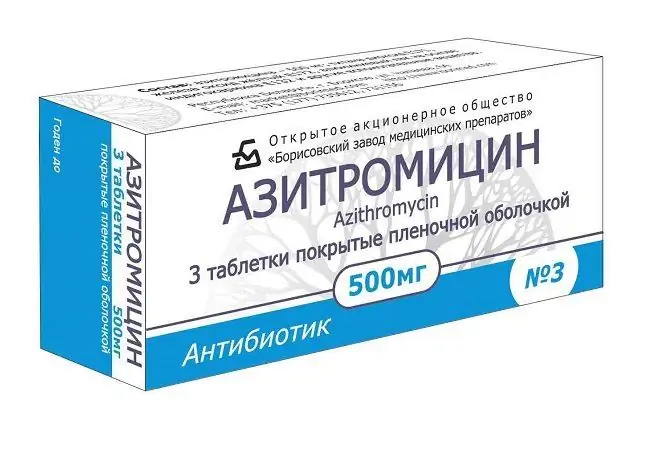- Author Rachel Wainwright [email protected].
- Public 2024-01-15 19:51.
- Last modified 2025-11-02 20:14.
How many days with angina does the temperature hold in children and adults
The content of the article:
- Possible reasons for the temperature rise
- Can there be angina without temperature
- Is hyperthermia harmful for angina
- How long does the temperature last for angina in adults and children
-
Do I need to bring down the temperature
- The opinion of Dr. Komarovsky
- When hospitalization is required
- Video
The temperature with angina is one of the main symptoms. The severity of hyperthermia and its duration depends on the form of the pathology and the severity of its course.

An increase in body temperature is one of the main symptoms of sore throat.
In acute tonsillitis, an increase in body temperature is the second most important symptom after local changes in the tonsils - redness, increase in size, formation of films, ulcers or purulent contents on their surface.
Pathology can occur without severe fever, for example, with catarrhal sore throat. Usually, in this case, the fever is either completely absent, or does not exceed subfebrile values (37.1-38.0 ° C). If the catarrhal form is not treated, it flows into purulent, lacunar or follicular, which are accompanied by the addition of various septic complications, including hyperthermia.
Possible reasons for the temperature rise
The development of angina is associated with the penetration of pathogens of various origins into the tissues of the glands.

Various pathogens lead to the development of the disease, which can be transmitted by contact and everyday life.
These include pathogenic or opportunistic microorganisms that have become active against the background of a decrease in immunity - bacteria, viruses, fungi. Some of them are present in the oral cavity and nasopharynx in all people and are part of the normal microflora, while others enter the body from the outside by airborne droplets or through household use.
The mechanisms that trigger the process of increasing body temperature in acute tonsillitis include:
- the release of toxins by pathogenic microorganisms;
- the release of biologically active substances occurring against the background of inflammation of the tissue of the glands;
- activation of the synthesis and decay of molecules of adenosine triphosphoric acid, which, under the influence of pathogens, enhances the process of internal heat production;
- a change in the level of hormones, leading to a violation of their functionality. Since there are neuroendocrine connections between the tonsils and the main endocrine glands, an increase / decrease in hormone levels can affect metabolism and contribute to an imbalance between internal heat production and heat transfer.
Exposure to toxins and inflammation are the two main causes of fever in both angina and other infectious diseases.
The development of inflammation leads to the active reproduction of pathogens that have penetrated the epithelial barrier of the glands. Foreign microorganisms destroy tonsil tissue and release toxins. In response, the protective cells of the immune system secrete biologically active substances that act on the thermoregulatory center in the brain - which is why the temperature begins to rise.
Can there be angina without temperature
What temperature should there be for angina? With a mild course, acute tonsillitis may not be accompanied by fever. In this case, the inflammatory process is localized only on the mucous membrane of the tonsils and proceeds without suppuration. At the same time, the temperature either remains within normal limits, or increases slightly (up to 37.5 degrees).

With a mild course, the disease can manifest itself only by local symptoms - redness and an increase in the size of the tonsils
In addition to the catarrhal form, without heat, angina can occur with necrotizing acute tonsillitis, in elderly patients and in the following cases:
- infection with yeast-like fungi from the genus Candida in children. In this case, the disease is called tonsillomycosis;
- exacerbation of chronic tonsillitis in adults, when inflammation resumes by activating the existing opportunistic microflora in the oral cavity, and not by adding new bacterial agents;
- period after a prolonged course of other diseases.
The necrotic ulcerative form (Simanovsky's angina) develops against the background of a nonspecific symbiosis of microorganisms living in the oral cavity after a severe infection.
The disease is characterized by the absence of hyperthermia, which is explained by the suppression of immunity activity due to a decrease in the general resistance of the organism. In this case, the absence of fever indicates not an easy course of pathology, but suppression of the immune system.
Is hyperthermia harmful for angina
In general, hyperthermia acts as a kind of immunity fight against pathogenic agents. In high heat, bacteria, viruses or fungi stop multiplying, lose some of their properties, and often die.

Pathogens die under the influence of high temperatures
The cells, which are the natural microflora of the body, are resistant to the effects of elevated temperature, therefore, only foreign microorganisms are destroyed by fever.
However, if the high temperature with angina lasts for a long time, it can adversely affect the functioning of vital organs. Under the influence of fever, pathological spasm of peripheral vessels is possible, leading to the centralization of blood circulation.
This emergency response is an attempt by the body to adapt to the conditions that have arisen and to increase blood flow to the brain suffering from oxygen starvation. On the other hand, it also leads to complex consequences - inhibition of the adrenal cortex, overload of the cardiovascular system, pulmonary edema and the appearance of abdominal pain.

In case of severe intoxication, hospitalization may be required
It should be borne in mind that a strong and prolonged fever reflects a pathological reaction to severe intoxication. With her, the patient requires hospitalization and emergency intensive care, especially when it comes to children under 3 years of age.
How long does the temperature last for angina in adults and children
The severity of the temperature reaction directly depends on the type of disease, the severity of intoxication, the depth of the inflammatory process and the existing complications.
In cases of primary acute tonsillitis and a mild course of the disease, increased values on the thermometer are noted, as a rule, for 2-3 days. Moreover, in cases of catarrhal sore throat, they do not exceed 38 ° C, and in case of lacunar or follicular sore throat, they reach 39-40 ° C.
Hyperthermia in all acute tonsillitis is conventionally divided into two types:
| Hyperthermia type | Features of the flow |
| White fever | It develops due to pathological spasm of peripheral vessels. It is accompanied by severe chills and lethargy, the skin becomes pale, damp and cold. With its development, immediate antipyretic therapy is required |
| Red fever | Its appearance is due to persistent expansion of peripheral blood vessels. With it, the skin becomes hot and dry, and the mucous membrane of the mouth / nose and facial skin becomes red |
In secondary acute tonsillitis, the temperature level is influenced by the characteristic features of the underlying pathology. In general, a fever with such tonsillitis can last from 3 to 6 days.
For example, hyperthermia with herpes sore throat stays at around 39-40 ºС for 2-3 days, if there are no complications. During this period, bubbles appear on the surface of the tonsils, uvula, throat wall, soft and hard palate, containing a grayish-cloudy exudate. When the bubbles break open to form a defect, the body temperature decreases.
Do I need to bring down the temperature
Fever against the background of sore throats is quite difficult to tolerate. The acute period begins with a pronounced chill and a sharp increase in temperature to 38-40 ° С, within which it can fluctuate for several days.

In some cases, patients take antipyretics even with a slight increase in temperature
Usually, patients begin taking Paracetamol and other antipyretics to improve their condition, even with insignificant thermometer values.
Considering that fever acts as a natural defensive reaction of the body, through which it tries to destroy pathogenic agents, with a relatively good condition of the patient, a wait-and-see tactic is recommended in relation to the intake of such funds.
The main goal of the treatment being carried out is, first of all, to destroy the focus of the inflammatory process. Depending on the pathogen, the otolaryngologist may prescribe antibiotics, antiviral or antifungal agents. Fever-reducing drugs should only be used as symptomatic adjunct to first-line drugs.
The opinion of Dr. Komarovsky
Doctor Komarovsky recommends taking measures at temperature to ensure the body is able to lose heat. This can be achieved in two ways:
- increased sweating - the patient should consume plenty of warm drink;
- creating conditions under which the body will warm the inhaled air - the temperature in the room in which the patient is located should be no more than 18 ºС.
Subject to these conditions, it is highly likely that the body will cope with the fever on its own.
When hospitalization is required
Compulsory hospitalization of the patient is required in cases when hyperthermia appears:
- excessive sleepiness;
- agitation / lethargy;
- an increase in intoxication;
- abdominal pain;
- deterioration of the general condition;
- muscle twitching and flinching;
- change in heart rate;
- strengthening of the vascular pattern on the skin;
- bluish tint of lips and fingertips;
- pallor of the limbs.
In such cases, all necessary medications are administered parenterally under the control of the functions of vital organs.
Whatever temperature may be with angina, it must be reported to the ENT in order to avoid the development of potential complications and irreversible autoimmune disorders.
Video
We offer for viewing a video on the topic of the article.

Anna Kozlova Medical journalist About the author
Education: Rostov State Medical University, specialty "General Medicine".
Found a mistake in the text? Select it and press Ctrl + Enter.






